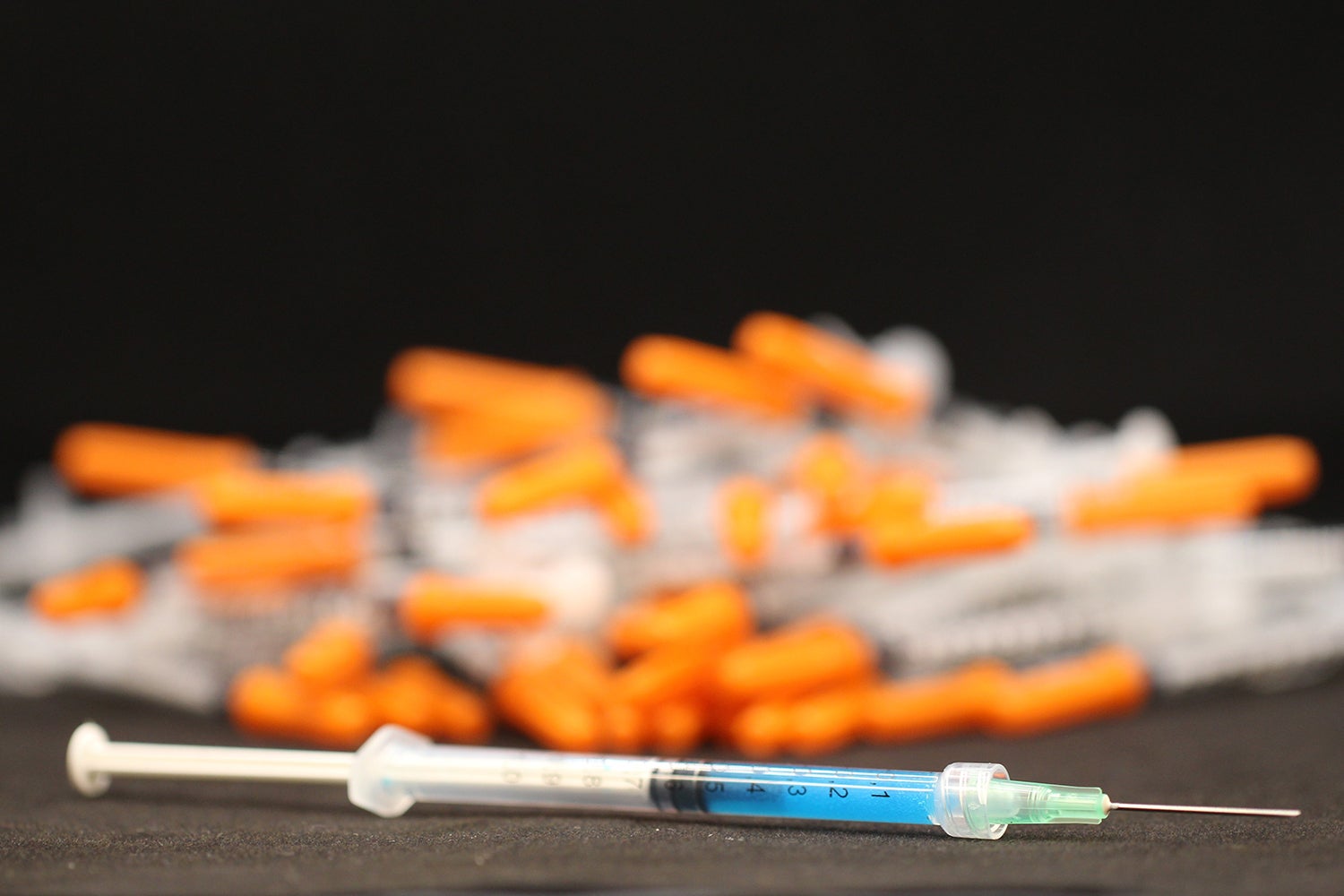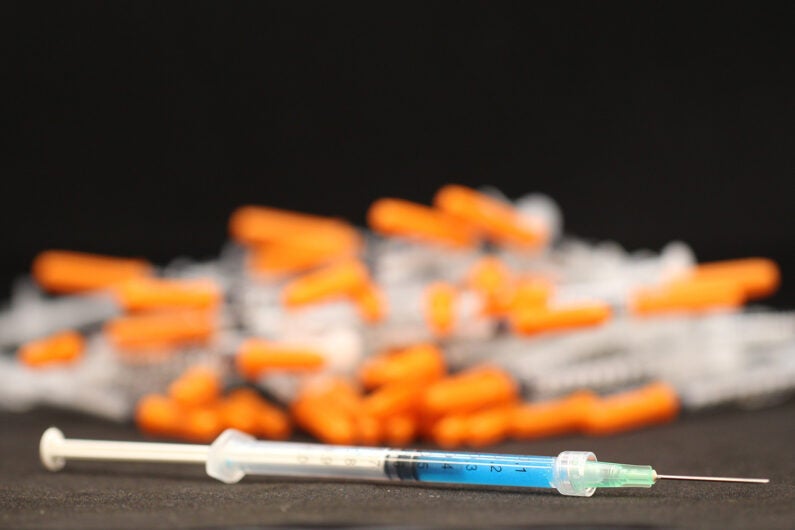
Drug delivery system could reduce daily diabetes shots to just three a year | Stanford News
Dietary management drugs have transformed Type 2 diabetes care, but daily injection routines are challenging for some patients. A new hydrogel could mean shots just three times a year.
NOVEMBER 21, 2023
New drug delivery system could reduce daily diabetes shots to just three a year
Dietary management drugs have transformed Type 2 diabetes care, but daily injection routines are challenging for some patients. A new hydrogel could mean shots just three times a year.BY ANDREW MYERS

Stanford engineers have developed an injectable hydrogel depot technology that enables GLP-1 drugs to be administered once every four months, compared to repeated daily injections. The single-injection, hydrogel-based drug product can dramatically reduce the frequency of therapeutic interventions, significantly increasing patient quality of life and reducing complications of diabetes management. (Image credit: Andrea Ivana d'Aquino)
Materials engineers at Stanford University have developed a novel hydrogel drug delivery system that transforms daily or weekly injections of diabetes and weight control drugs like Ozempic, Mounjaro, Trulicity, Victoza, and others to just once every four months. In a new study, published Nov. 21 in Cell Reports Medicine, researchers believe that such a system will greatly improve management of both diabetes and weight, improve patient drug compliance, and help those with Type 2 diabetes improve long-term health outcomes.
These drugs all work by mimicking the hormone glucagon-like peptide 1 (GLP-1). But, as good as they are at helping people manage their diets and their weight, the typical daily or weekly injections are a burden for many patients.
“Adherence is one of the biggest challenges in Type 2 diabetes management,” said Eric Appel, associate professor of materials science and engineering at Stanford and principal investigator on the new hydrogel that allows the slow release of the diet control drugs over many months. “Needing only three shots a year would make it much easier for people with diabetes or obesity to stick with their drug regimens.”
Half a billion people worldwide suffer from Type 2 diabetes, including 130 million in America alone. Treatment is estimated to cost the United States upward of $400 billion each year. Introduced only recently, the GLP-1 drugs have been described as “miracle drugs” with few side effects and profound control of energy intake by helping patients feel more satiated and less hungry, and by targeting other reward-related dietary effects.
“Our hydrogel melts away over many months like a sugar cube dissolving in water, molecule by molecule,” Appel explained. “I often refer to the mesh being held together by a sort of molecular Velcro that sticks together quite well, but then can be easily pulled apart.”
The new hydrogel, technically known as a polymer-nanoparticle (PNP) hydrogel, has a Goldilocks “just right” quality of fluidlike flow that can be easily injected using off-the-shelf needles, yet a gel-like stability durable enough in the body to last the full four-month period. Molecules of the GLP-1 drugs are formulated into the hydrogel and are similarly doled out over time as the hydrogel slowly melts away.
The physician injects a small dollop of gel, known as a “depot,” of the drug-laden hydrogel under the skin in a convenient location such as under the arm. The key for the engineer is to design the hydrogel in such a way as to make this depot small enough to be comfortable and inconspicuous to the patient, yet large enough and durable enough to last the full four months. Appel believes his team has achieved that measure of control.
“We chose four months to match the cadence that people actually meet with their physician or endocrinologist and why we were so specific with the release period,” Appel said.
While this particular hydrogel was engineered specifically for the GLP-1 four-month checkup regimen, Appel said that the team has successfully tuned the release timeframes to anywhere from days to upward of six months. He adds that such systems have been used with other proteins, vaccines, and even therapeutic cells, and there is evidence that GLP-1 drugs can also reduce risk of cardiovascular disease. All these signs point to the promising possibility that this drug delivery system can be applied to other drugs and other conditions.
“There’s even been really promising results with children with Type 1 diabetes,” Appel said of the promise ahead.
Next up will be tests in pigs, whose skin and endocrine systems are most similar to those in humans. If those trials go according to plan, Appel could see human clinical trials within a year and a half to two years.
“At the very least, we have laid a pathway for the prolonged release of therapeutic GLP-1–based anti-diabetic and anti-obesity treatments that could have beneficial impact on Type 2 diabetes management and, perhaps, other conditions as well,” Appel said.
Additional co-authors are postdoctoral fellow Andrea d’Aquino (lead author); former graduate students Caitlin Maikawa, PhD ’21, and Catherine Kasse, PhD ’22; PhD students Leslee Nguyen and Jerry Yan; graduate students Katie Lu, Ian Hall, and Carolyn Jons; postdoctoral fellow Alexander Prossnitz; undergraduate researcher Enmian Chang; and clinical veterinarian Sam Baker. Researchers from Novo Nordisk are also co-authors. Appel is a senior fellow at the Stanford Woods Institute for the Environment, a faculty fellow of Sarafan ChEM-H, and a member of Stanford Bio-X, the Cardiovascular Institute, the Wu Tsai Human Performance Alliance, the Maternal & Child Health Research Institute (MCHRI), the Stanford Cancer Institute, and the Wu Tsai Neurosciences Institute.
This research was funded in part by a grant from the National Institute of Diabetes and Digestive and Kidney Diseases and by a seed grant from the Stanford Diabetes Research Center.

Stanford engineers have developed an injectable hydrogel depot technology that enables GLP-1 drugs to be administered once every four months, compared to repeated daily injections. The single-injection, hydrogel-based drug product can dramatically reduce the frequency of therapeutic interventions, significantly increasing patient quality of life and reducing complications of diabetes management. (Image credit: Andrea Ivana d'Aquino)
Materials engineers at Stanford University have developed a novel hydrogel drug delivery system that transforms daily or weekly injections of diabetes and weight control drugs like Ozempic, Mounjaro, Trulicity, Victoza, and others to just once every four months. In a new study, published Nov. 21 in Cell Reports Medicine, researchers believe that such a system will greatly improve management of both diabetes and weight, improve patient drug compliance, and help those with Type 2 diabetes improve long-term health outcomes.
These drugs all work by mimicking the hormone glucagon-like peptide 1 (GLP-1). But, as good as they are at helping people manage their diets and their weight, the typical daily or weekly injections are a burden for many patients.
“Adherence is one of the biggest challenges in Type 2 diabetes management,” said Eric Appel, associate professor of materials science and engineering at Stanford and principal investigator on the new hydrogel that allows the slow release of the diet control drugs over many months. “Needing only three shots a year would make it much easier for people with diabetes or obesity to stick with their drug regimens.”
Half a billion people worldwide suffer from Type 2 diabetes, including 130 million in America alone. Treatment is estimated to cost the United States upward of $400 billion each year. Introduced only recently, the GLP-1 drugs have been described as “miracle drugs” with few side effects and profound control of energy intake by helping patients feel more satiated and less hungry, and by targeting other reward-related dietary effects.
Novel nanocomposite hydrogels
The secret of the hydrogel is in the unique physical characteristics of the nanoparticles at its heart. Hydrogels are not new – many people today wear contact lenses made of hydrogels, for instance – but these are engineered to resist tearing and to hold their shape. Appel’s hydrogel is instead engineered with polymers and nanoparticles that are weakly bound to one another, so as to hold together as a gel yet dissipate slowly over time. The hydrogel is formed from a mesh of polymer chains and nanoparticles that hold the drug molecules until the mesh dissolves away, releasing the drugs.“Our hydrogel melts away over many months like a sugar cube dissolving in water, molecule by molecule,” Appel explained. “I often refer to the mesh being held together by a sort of molecular Velcro that sticks together quite well, but then can be easily pulled apart.”
The new hydrogel, technically known as a polymer-nanoparticle (PNP) hydrogel, has a Goldilocks “just right” quality of fluidlike flow that can be easily injected using off-the-shelf needles, yet a gel-like stability durable enough in the body to last the full four-month period. Molecules of the GLP-1 drugs are formulated into the hydrogel and are similarly doled out over time as the hydrogel slowly melts away.
The physician injects a small dollop of gel, known as a “depot,” of the drug-laden hydrogel under the skin in a convenient location such as under the arm. The key for the engineer is to design the hydrogel in such a way as to make this depot small enough to be comfortable and inconspicuous to the patient, yet large enough and durable enough to last the full four months. Appel believes his team has achieved that measure of control.
“We chose four months to match the cadence that people actually meet with their physician or endocrinologist and why we were so specific with the release period,” Appel said.
Promising potential
So far, the team has tested the new drug delivery system in laboratory rats with high success. In rats, a single injection of this hydrogel-based therapy improves management of blood glucose and weight compared to daily injections of a leading commercial drug, Appel noted.While this particular hydrogel was engineered specifically for the GLP-1 four-month checkup regimen, Appel said that the team has successfully tuned the release timeframes to anywhere from days to upward of six months. He adds that such systems have been used with other proteins, vaccines, and even therapeutic cells, and there is evidence that GLP-1 drugs can also reduce risk of cardiovascular disease. All these signs point to the promising possibility that this drug delivery system can be applied to other drugs and other conditions.
“There’s even been really promising results with children with Type 1 diabetes,” Appel said of the promise ahead.
Next up will be tests in pigs, whose skin and endocrine systems are most similar to those in humans. If those trials go according to plan, Appel could see human clinical trials within a year and a half to two years.
“At the very least, we have laid a pathway for the prolonged release of therapeutic GLP-1–based anti-diabetic and anti-obesity treatments that could have beneficial impact on Type 2 diabetes management and, perhaps, other conditions as well,” Appel said.
Additional co-authors are postdoctoral fellow Andrea d’Aquino (lead author); former graduate students Caitlin Maikawa, PhD ’21, and Catherine Kasse, PhD ’22; PhD students Leslee Nguyen and Jerry Yan; graduate students Katie Lu, Ian Hall, and Carolyn Jons; postdoctoral fellow Alexander Prossnitz; undergraduate researcher Enmian Chang; and clinical veterinarian Sam Baker. Researchers from Novo Nordisk are also co-authors. Appel is a senior fellow at the Stanford Woods Institute for the Environment, a faculty fellow of Sarafan ChEM-H, and a member of Stanford Bio-X, the Cardiovascular Institute, the Wu Tsai Human Performance Alliance, the Maternal & Child Health Research Institute (MCHRI), the Stanford Cancer Institute, and the Wu Tsai Neurosciences Institute.
This research was funded in part by a grant from the National Institute of Diabetes and Digestive and Kidney Diseases and by a seed grant from the Stanford Diabetes Research Center.